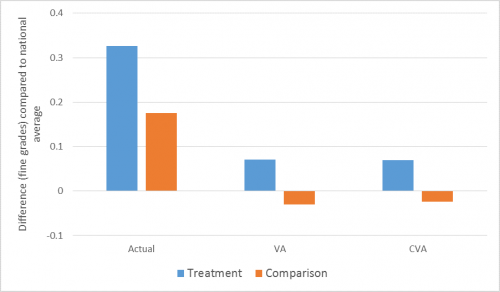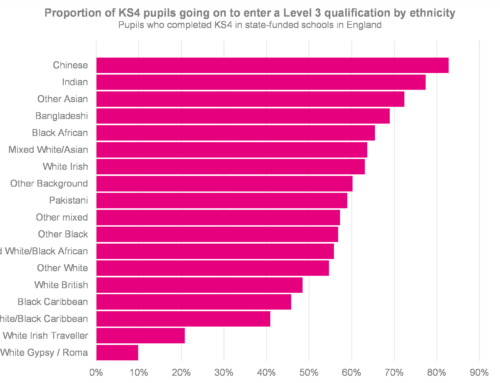Over the weekend the Daily Mail reported on plans to open the first new Grammar School in 50 years. The arguments for and against Grammar Schools as agents of educational improvement and social mobility will doubtless be rehearsed with even greater vigour in the coming months.
In this blog we look at whether private tuition and additional coaching in preparation for the 11 plus boosts primary schools’ Key Stage 2 test results.
To begin with, we identify 117 primary schools with KS2 results in 2014 that sent at least 50% of their pupils (and a minimum of 5 pupils) to Grammar schools in Autumn 2014. We refer to this group as the ‘treatment’ group.
Of course we do not know for certain whether pupils at these schools did receive any private tuition or coaching. We can only assume that if it goes on, then at least some of these pupils will have received it.
For each of the 117 schools, we identify a statistically similar ‘comparison’ school from amongst the set of schools that have not sent any pupils to Grammar schools over the last five years. We don’t know the extent to which pupils at these schools participate in private tuition or coaching.
Statistical similarity is established based on:
- Estimated KS2 results (given KS1 results)
- % EAL
- % FSM in the last 6 years
- % with SEN
- % resident in 30% least deprived areas measured by IDACI
- % resident in 30% most deprived areas measured by IDACI
- Mean year group size
- Population density of the area in which a school is located
- Age range (infant-only, junior-only, infant + junior)
In Figure 1 we look at differences between the ‘treatment’ and ‘comparison’ group in KS2 mean fine grade (reading, writing and mathematics) in 2014. Actual attainment for both groups was above the national average but there was a difference of 0.15 fine grades (0.2 of a national standard deviation) between the two groups.
Figure 1: Difference between treatment and comparison schools in KS2 mean fine grade (reading, writing, mathematics) 2014

The groups based on similar schools are fairly well balanced in terms of prior attainment and pupil characteristics but because statistical similarity was calculated based on all pupils on roll (rather than just year 6 pupils), there are some minor imbalances. Differences in pupil prior attainment can be smoothed out in value added (VA) calculations and differences in characteristics (EAL, SEN, FSM etc.) can additionally be removed in contextual value added (CVA) calculations. These reduce the differences between ‘treatment’ and ‘comparison’ schools to 0.1 fine grades (0.13 standard deviations) for VA and 0.09 fine grades[1] (0.12 standard deviations) for CVA.
If plans for the ‘new’ Grammar School in Sevenoaks do go ahead then we might expect to see small improvements in attainment in surrounding primary schools.
(This observation that the presence of grammar schools impacts on primary school education as much as it does secondary school education was made by Pischke and Manning (2006)[2] in response to Galindo-Rueda and Vignoles’ (2004)[3] research on grammar schools in the 1970 Birth Cohort Study.)
Thanks to Dave Hollomby from Wirral for the idea for this blog.






[…] the impact of tutoring for the test amongst higher income families. This is because tutoring almost certainly raises SATs scores in selective LAs. (Indeed, whether or not selection effects primary school progress was the topic […]